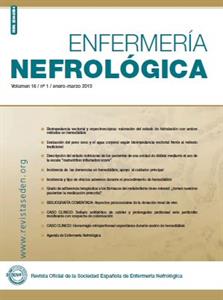Contenido del artículo principal
Resumen
La seguridad del paciente constituye hoy día una prioridad para las principales organizaciones de salud como la Organización Mundial de la Salud, organismos internacionales como la Unión Europea, el Consejo de Europa, autoridades sanitarias, sociedades profesionales y organizaciones de pacientes.
Objetivo
Describir las incidencias y tipos de efectos adversos derivados de la hemodiálisis en una unidad de nefrología.
Metodología
Diseño: Estudio transversal en una unidad de hemodiálisis de 28 camas. Variables: como variable dependiente se consideró la presencia de efectos adversos y tipología, para ello se utilizó la Clasificación Internacional para la Seguridad del Paciente. Análisis estadísticos: se realizó una descripción de la muestra, para ello se utilizaron tanto los gráficos (histogramas, diagramas de barras y dispersión) como los porcentajes, medias, desviaciones típicas, medianas, etc. Resultados
Durante el periodo a estudio se practicaron un total de 4.797 procedimientos de hemodiálisis, en un total de 681 sesiones produjeron efectos adversos, lo que supone una tasa de incidencia de 141,96 cada 1.000 diálisis. En cuanto a la gravedad el 97,5% de los efectos adversos fueron clasificados como leves, frente al 1,8% y 0,7% que fueron considerados como moderados y graves respectivamente. Conclusiones
Nuestra tasa de incidencia y gravedad de los efectos adversos es similar a la de otros centros. Este estudio nos permite identificar los problemas de seguridad en nuestra Unidad y en una segunda fase realizar un protocolo conjunto, que nos permita disminuir la tasa de incidencia actualmente existente. La hipotensión fue el efecto adverso más frecuente.
Palabras clave
Detalles del artículo
Derechos de autor 2013 Estela Matarán Robles, Rafael Aguilar García Aguilar García, Mercedes Muñoz Becerra

Esta obra está bajo una licencia internacional Creative Commons Atribución-NoComercial 4.0.
Aviso de derechos de autor/a
© Los autores ceden de forma no exclusiva los derechos de explotación de los trabajos publicados y consiente en que su uso y distribución se realice con la Licencia Creative Commons Atribución - No comercial 4.0 Internacional (CC BY-NC 4.0). Puede consultar desde aquí la versión informativa y el texto legal de la licencia. Esta circunstancia ha de hacerse constar expresamente de esta forma cuando sea necesario.
Referencias
- Seguridad del paciente. Ministerio de Sanidad, Servicios Sociales e Igualdad. Acceso febrero 2013.Disponible en http://www.seguridaddelpaciente.es.
- Aranaz JM, Aibar C, Vitaller J, Ruiz P. Estudio nacional sobre efectos adversos ligados a la hospitalización. Eneas. Madrid. Ministerio de sanidad y Consumo.2006.
- Observatorio para la seguridad del paciente. Junta de Andalucía. Agencia de calidad Sanitaria. Acceso febrero 2013.Disponible en http://juntadeandalucia.es/agenciadecalidadsanitariadeandalucia/observatorioseguridaddelpaciente.
- Rojo Tordable M, Sánchez Cano MS, Cepa García H. Atención de enfermería durante la sesión de hemodiálisis. En Alonso Nantes Rr; Pelayo Alonso R. Manual de Enfermería Nefrológica. Barcelona: Ediciones Pulso;2012:165-191.
- Plan de Seguridad del paciente en hemodiálisis. María Antonia Álvarez de Lara Sánchez. Saludinnova.com. Banco de practicas innovadoras. fecha de publicación: 21/04/2010. Disponible en: http://www.saludinnova.com/practices.
- Holley JL. A descriptive report of error and adverse events in chronic hemodialysis Units. Nephrol News Issues. 2006; 20(12):57-63.
- Aranaz JM, Aibar C, Vitaller J, Ruiz P. Estudio nacional sobre efectos adversos ligados a la hospitalización. Eneas. Madrid. Ministerio de sanidad y Consumo. 2006.
Referencias
Seguridad del paciente. Ministerio de Sanidad, Servicios Sociales e Igualdad. Acceso febrero 2013.Disponible en http://www.seguridaddelpaciente.es.
Aranaz JM, Aibar C, Vitaller J, Ruiz P. Estudio nacional sobre efectos adversos ligados a la hospitalización. Eneas. Madrid. Ministerio de sanidad y Consumo.2006.
Observatorio para la seguridad del paciente. Junta de Andalucía. Agencia de calidad Sanitaria. Acceso febrero 2013.Disponible en http://juntadeandalucia.es/agenciadecalidadsanitariadeandalucia/observatorioseguridaddelpaciente.
Rojo Tordable M, Sánchez Cano MS, Cepa García H. Atención de enfermería durante la sesión de hemodiálisis. En Alonso Nantes Rr; Pelayo Alonso R. Manual de Enfermería Nefrológica. Barcelona: Ediciones Pulso;2012:165-191.
Plan de Seguridad del paciente en hemodiálisis. María Antonia Álvarez de Lara Sánchez. Saludinnova.com. Banco de practicas innovadoras. fecha de publicación: 21/04/2010. Disponible en: http://www.saludinnova.com/practices.
Holley JL. A descriptive report of error and adverse events in chronic hemodialysis Units. Nephrol News Issues. 2006; 20(12):57-63.
Aranaz JM, Aibar C, Vitaller J, Ruiz P. Estudio nacional sobre efectos adversos ligados a la hospitalización. Eneas. Madrid. Ministerio de sanidad y Consumo. 2006.




